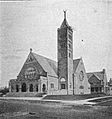First Congregational Church (Detroit) facts for kids
|
First Congregational Church
|
|
|
U.S. Historic district
Contributing property |
|
|
.
First Congregational Church in 2019, photograph by Carol M. Highsmith.
|
|
| Location | 33 East Forest Avenue Detroit, Michigan |
|---|---|
| Built | 1891; 1921 (addition) |
| Architect | John Lyman Faxon; Albert Kahn |
| Architectural style | Romanesque Revival |
| NRHP reference No. | 79001173 |
Quick facts for kids Significant dates |
|
| Added to NRHP | June 4, 1979 |
The First Congregational Church is a historic building located in Midtown Detroit, Michigan. You can find it at 33 East Forest Avenue, right on the corner of Forest and Woodward Avenue. This important church was recognized as a Michigan State Historic Site in 1974. A few years later, in 1979, it was also added to the National Register of Historic Places.
Contents
History of the Church
The First Congregational Church of Detroit began a long time ago, on December 25, 1844. The first two church buildings were built close to the Detroit River. The third building, which is the one you see today, was finished in 1891. It was designed by an architect named John Lyman Faxon. Later, in 1921, a famous architect named Albert Kahn designed an addition to the church. This part is known as the Angel's Wing.
In the early 1900s, Gaius Glenn Atkins served as the church's minister two different times.
Church Architecture and Design
The church's design is a mix of two old styles: Romanesque and Byzantine. It is built using rough, warm red limestone. The front of the church, facing Woodward Avenue, has a special covered walkway called a five-bay loggia. Above this, you can see rounded windows with fancy stone patterns.
The church also has a tall bell tower, called a campanile, which is 120 feet high. This tower has many narrow arched openings. At the very top of the church, there is an 8-foot copper statue of the Archangel Uriel.
The design of the church was inspired by beautiful churches found in cities like Venice and Ravenna. The main worship area, called the sanctuary, looks similar to the lower church of St. Francis of Assisi. It features detailed carved wood, paintings on the ceiling, round stained-glass windows called rose windows, and rich, bright colors. The amazing paintings inside were created by Lyle Durgin and finished in December 1891.
Living Museum and Tours
Today, the church acts like a "living museum." It has exhibits that teach visitors about the church's history, its buildings, and the activities that have taken place there over the years. You can take a self-guided tour to explore the historic parts of the church and its buildings.
The church is also home to the Underground Railroad Living Museum. This museum offers a special storytelling experience that helps visitors understand what the original Underground Railroad was like. It's a way to learn about an important part of history through a unique simulation.
Gallery
-
The angel Uriel atop the First Congregational Church
See also
 In Spanish: Primera Iglesia Congregacional (Detroit) para niños
In Spanish: Primera Iglesia Congregacional (Detroit) para niños





